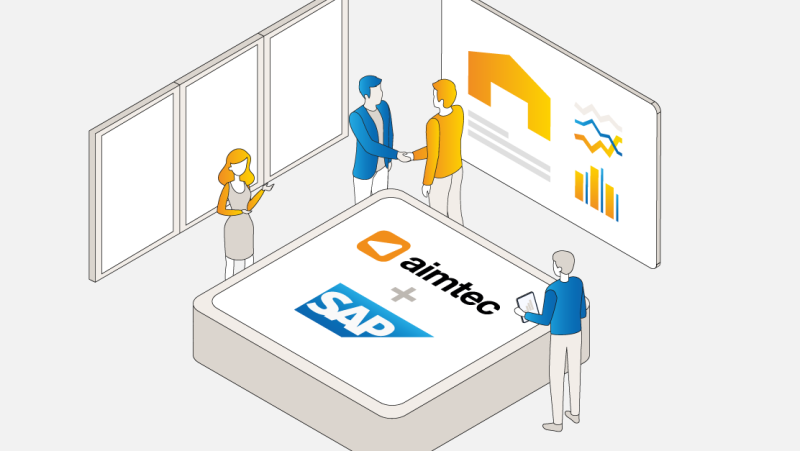Interview with Jan Kratochvil: About new features in SAP system, migration to SAP S/4HANA and cloud solutions
- SAP S/4HANA
- Interview
SAP is one of the world’s most widespread ERP systems. And this solution’s user community is preparing for a change that its producer announced back in 2015 – the migration to SAP’s new S/4HANA generation. How are companies preparing for this transition, what new things is it bringing, and what possibilities are opening up for users? We spoke about all of this with Aimtec’s SAP Solutions Director Jan Kratochvil.
Jan, support for SAP’s current version will be ending in 2027. What does the SAP S/4HANA transition mean for users?
Above all, that they will be working with a platform whose development is guaranteed until at least 2040. This is a faster and more stable system with a modern user interface. We must keep in mind that the present version stems from a solution that’s been evolving since 1973. Can you imagine what industry was like in that era versus today? SAP S/4HANA is not a new version of this solution; it’s an entirely new product. One that’s ready to support the transformation of business, integrate new technologies and harness advanced technologies such as real-time analyses, artificial intelligence and machine learning.
A rather common concern is losing custom development, which represents significant time and money invested over the years. Is it at all realistic to bring these modifications into the new system?
Yes, there’s a tool called Readiness Check for evaluating the technical state of a system. It analyses the system’s current state and verifies that its configuration, including all custom modifications, is compatible with the transition to SAP S/4HANA. However, we recommend that you also consider whether, after years of use, your current system configuration corresponds with your company’s reality. We advise our customers to use the SAP S/4HANA transition as a chance to review their internal processes and development vision. You also need to keep in mind that SAP S/4HANA is an enormous technological leap forward. Things that the current system can’t do and you’ve had to add via programming, the new system likely can do within one of its standard tools. But naturally, most modifications will be possible. For example Sappy – an add-on we’ve developed for our customers – enables a smooth transition to the new system with no loss of special setups. Our solution has been fully SAP S/4HANA compatible since back in 2019.
SAP has been promoting a “cloud first” strategy, and new non-cloud deployments of the solution will not even be possible – what’s your opinion?
The majority of tech companies are switching to a “cloud-first” solution, due to the flexibility, scalability and innovations that cloud infrastructure provides. The transition to the cloud is a general trend, and it has its justification. In general, a deployment of SAP S/4HANA Cloud is faster than for traditional on-premise systems. A solution as a service is sustainable as well – for example upgrades and updates take place automatically. Over time, this solution also makes sense in terms of cost – the need for maintaining and securing in-house infrastructure falls away.
„Keep in mind that a system’s costs don’t just mean its licence fee, but also all its associated costs, which are often hard to quantify, while the costs of a cloud solution, conversely, are clear and transparent.“
Jan Kratochvil, SAP Solutions Director, Aimtec
How do you view the security of data in the cloud?
Cloud servers are far better protected against cyber attacks, technical faults etc. than poorly secured internal servers. Cyber attacks are unfortunately a reality, and their impacts can be devastating for a company. Minimising risks like these is essential, and so it is better to acquire this solution as a service.
The new system will be available in two cloud-based options – “public” and “private”. What is the difference between them, and which version suits whom?
To put it simply, you can think of the “private” option as a solution that’s fully customisable and extensible just like the current on-premise version of SAP. From the system standpoint, it’s single-tenant, with each customer having their own “isolated” system. SAP S/4HANA Cloud Private Edition is the preferred solution mainly for large companies with non-standard processes and special configuration requirements, or corporations with many branches – for which this option also makes sense financially.
The “public” version, meanwhile, does not offer the option of fully modifying the system – which we take as a benefit. And it’s in precisely this variant that we see the sustainable future of the corporate solution. System-wise, this solution is multi-tenant, and thus unified for all users at its core, with any special settings residing at the client level. This version is based on hundreds of scenarios, best practices, covering most of a company’s usual needs. And if you need to take care of a special process, the SAP Business Technology Platform (BTP) is available. You can develop special add-ons and extensions here, or download the existing ones in the SAP Store.
Are you at Aimtec planning to do development within BTP and place your applications on the SAP Store?
Yes, we’ve had to adapt our solutions to the changes that are taking place within SAP. We too are evolving and introducing a new generation of our add-on, now named Aimtec SCIx. It’s based on the current Sappy solution, ties into its benefits and further develops it. The fundamental thing is that it doesn’t matter which version of SAP S/4HANA you choose. In all cases we can support our customers in configuring their SAP environment so that it suits their needs.
And we are developing Aimtec SCIx within BTP as well. We’re planning to publish it on the SAP Store shortly. Here just as elsewhere, we are conceptually approaching the entire solution so that it allows us to cover specific needs throughout the digital factory without having to modify standard SAP. Our attention is centred on the user. Our goal is for the system to be perfectly adapted to the physical process, and not vice versa, thanks to the solution’s broad configurability.
Migrating to SAP S/4 HANA and adapting the system to specific needs within, for example, automotive, is truly a demanding process. Can you advise as to the main points of focus?
It is a demanding process, but on the other hand – hundreds of firms will go through it. It is nothing you cannot handle, even though I certainly wouldn’t call it a routine process. The important thing, of course, is to choose a suitable implementation partner, one with experience, and a strong enough team, especially for a roll-out across many branches. It’s also important not to undervalue internal resources – ultimately, this is likely the key thing, because an upgrade requires order primarily within the data you’ll be bringing into the new system; this tends to be the greatest obstacle to a well-working system, and not just during SAP S/4HANA migrations.
And an important question in closing. Why choose Aimtec as a partner for a migration to SAP S/4HANA?
Our strength lies in our enormous industry know-how; we have over 27 years of experience in manufacturing and logistics, particularly in the automotive environment. We can handle small and medium projects on our own, and for large projects that require thousands of man-days, cooperation with another implementation partner who handles the fundamentals of SAP S/4HANA deployment has proven successful. In parallel we are preparing the necessary changes, above all a mobile Fiori solution for manufacturing and logistics so that users will be able to utilise the new SAP simply and effectively.
The entire solution is then launched at once. This benefits everyone – the main implementation partner does not lose time developing a solution for which it lacks the expertise or capacity needed, and we focus on our specialisation. And what’s most important – the customer receives a fully functional and tailored system, which saves them time and money and, above all, simplifies the change process within their organisation. Users are then unafraid to use the system and believe in it. And that is priceless.
Share article
Top stories from logistics, production and IT.
Subscribe to Aimtec Insights
By registering, you agree to the processing of your personal data by Aimtec as described in the Privacy policy.
Get top stories and articles
from Logistics, Production and IT.
Subscribe to Aimtec Insights
By registering, you agree to the processing of your personal data by Aimtec as described in the Privacy policy.








